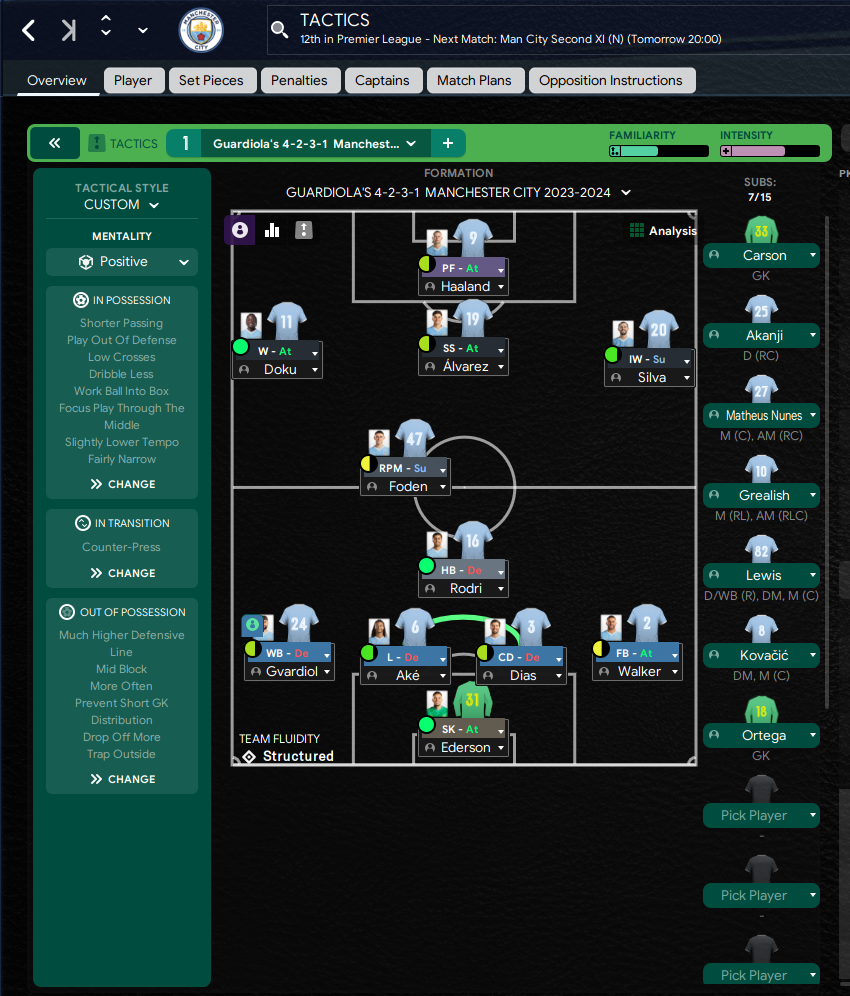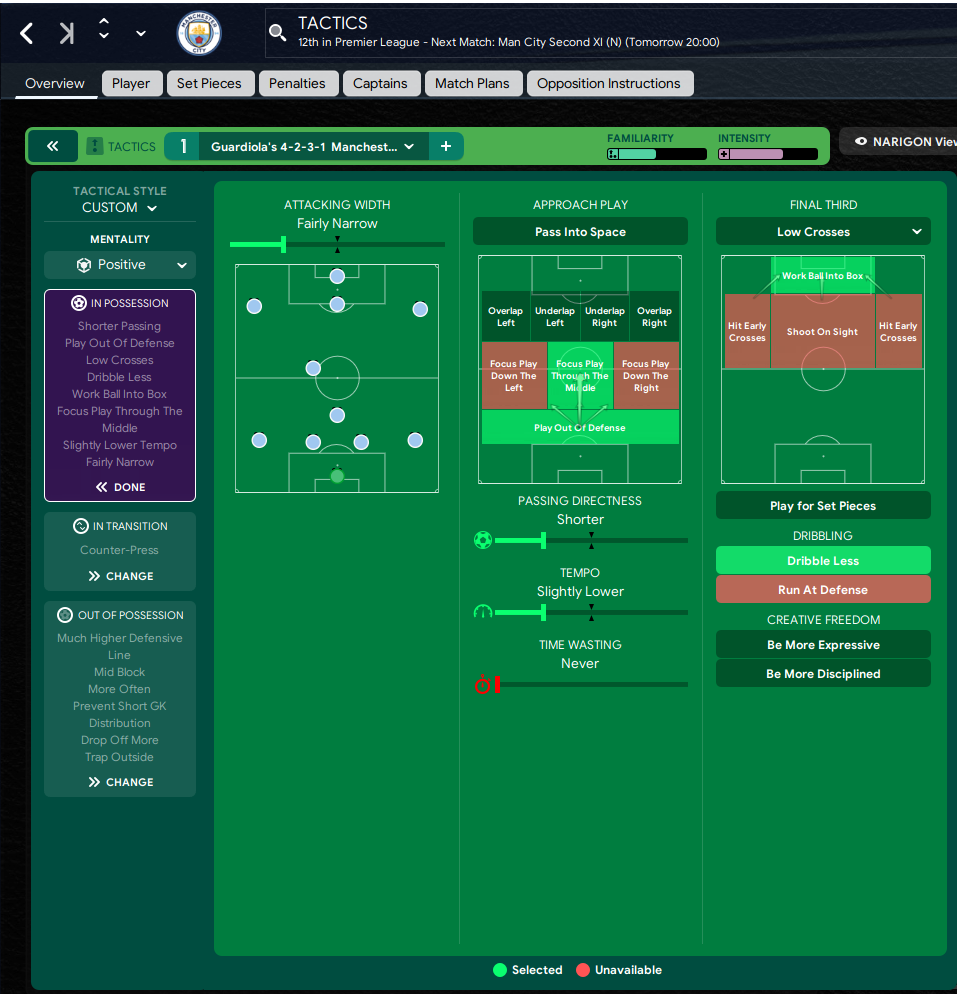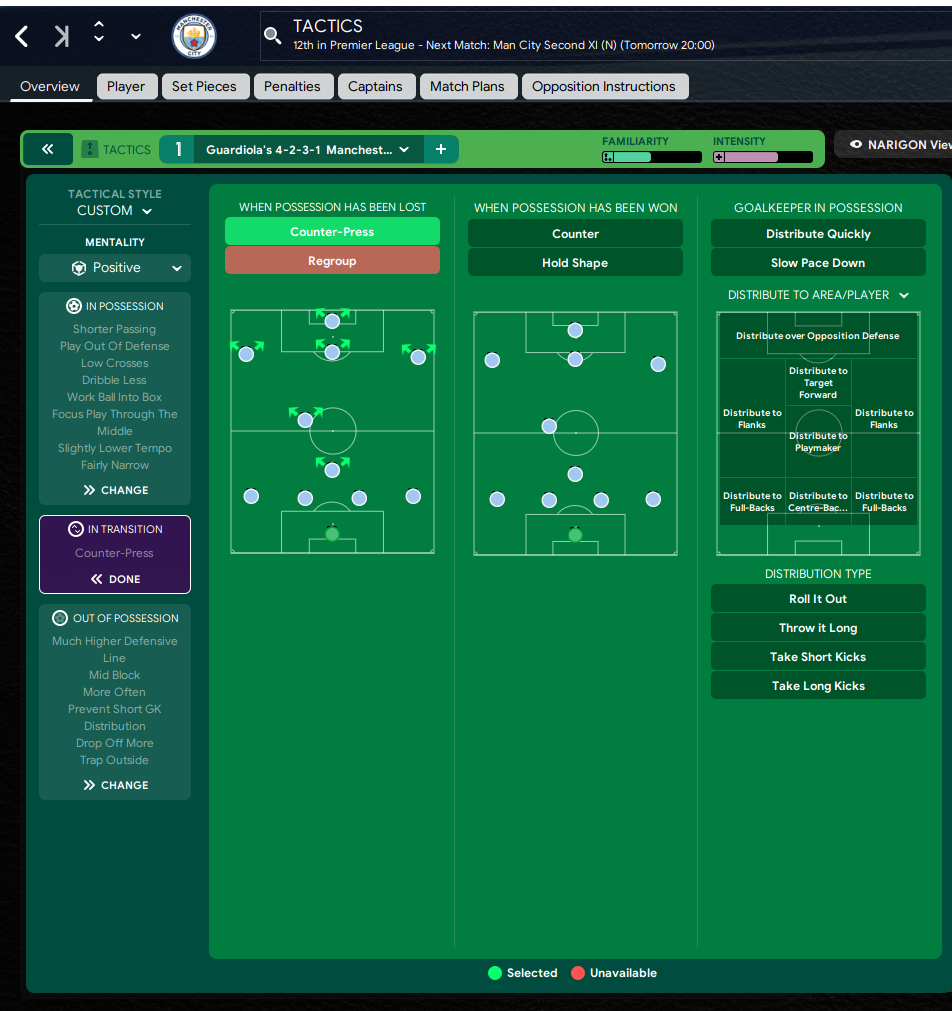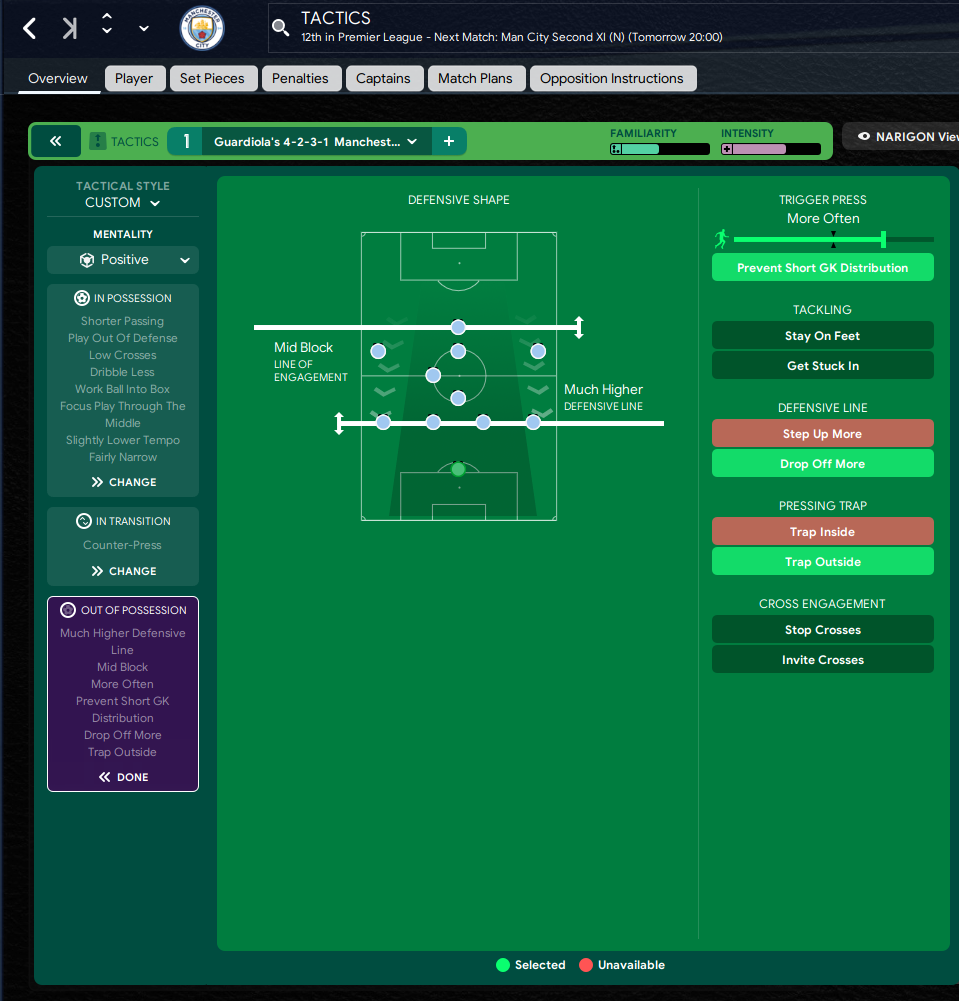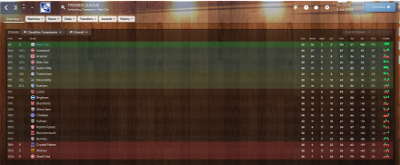| Tester | Team | ME | Win % | PPG | AGF | AGA | GD | PL | W | D | L | |
|---|---|---|---|---|---|---|---|---|---|---|---|---|
| Deleted User #1866315 |
 Manchester Regt.
Manchester Regt.
|
24.3 | 95% | 2.89 | 3.6 | 0.7 | 2.84 | 38 | 36 | 2 | 0 |
PEP GUARDIOLA’S 2023-2024 MANCHESTER CITY IN FOOTBALL MANAGER 2024
Tactical analysis
Let's take a look at how Pep Guardiola's Manchester City plays: its playing model, its principles, the tactics used, and the formations in different phases.
Since Pep Guardiola arrived at Manchester City in the 2016/2017 season, the English team has won 5 Premier League titles in 7 seasons. The Spanish coach has been able to create a dynasty, capable of dominating the most competitive league in the world. However, the team, and consequently its style of play, has not remained unchanged since Guardiola signed his first contract with the Citizens; in fact, there have been many key players used over the years, some have been sold, others have ended their careers, while others have been acquired by the club during the seasons, always ready to financially support the coach's requests. Furthermore, Guardiola has always been able to innovate, introducing tactical innovations year after year that have allowed him and his players to compete and win, both domestically and in the Champions League. After winning the treble in the 2022/2023 season, City is once again in contention for both the league title and the Champions League in 23/24. The principles of play remain the same that have made them successful over the years, but there are some new elements, both in terms of players and team attitude, that need to be analyzed to understand how the game of a team that continues to make history in modern football has evolved once again.
Base Formation: 1-4-2-3-1
In goal, there's Ederson, a highly skilled goalkeeper in ball distribution, heavily involved in building up play, left-footed. The defense consists of Akè, left-back, left-footed, fast and adept in tackling, though sometimes lacking in tracking runs behind him; Akanji, central defender, right-footed, who steps up to midfield to support Rodri in possession; Ruben Dias, central defender, excellent in tackles and aerial duels, stays back in cover during possession, right-footed; Walker, right-back, right-footed, also involved in offense, often delivering crosses and passes into the box. In midfield, we have Rodri, right-footed, adept at covering ground, acts as the link between defense and attack, present in defensive cover and offensive actions, and Bernardo Silva, left-footed midfielder, technically brilliant with great vision, excels in crosses and passes. In the attacking midfield, we have: Alvarez, operating as an attacking midfielder alongside B. Silva in possession, right-footed, with a keen eye for goal; Doku as the left-wing forward, right-footed, strong in one-on-one situations, frequently sought by teammates; Foden, right-wing forward, left-footed, skilled at dribbling and shooting from distance. Haaland is the central striker, possessing immense physicality, great speed, and aerial ability, one of the best strikers currently.
Possession Phase: 1-3-2-2-3
In possession, City's 4-2-3-1 aligns in 4 lines: 3 defenders (Akè, R. Dias, and Walker) with Walker being the one making more frequent attacking runs, the other two primarily tasked with defensive duties; 2 central midfielders, Akanji and Rodri, both in line, with Akanji on the left and Rodri on the right; 2 attacking midfielders, B. Silva and Alvarez, positioned in the "half-spaces" between midfield and the opposing defense, ready to receive passes between the lines from teammates; 3 forwards, two wingers, Doku on the left and Foden on the right, staying wide and high to receive the ball and take on their direct opponents, and a central striker, Haaland, positioned among the opposing defenders.
Non-Possession Phase: 1-4-1-4-1
Out of possession, a defensive line of 4 is formed, with Rodri positioned between midfield and defense acting as a filter, followed by a midfield line of 4 consisting of the two wide forwards, the attacking midfielder, and B. Silva, supporting the lone striker above the ball line, Haaland.
Possession Phase
Build-up
The build-up is predominantly low; during goal kicks, there's a 4+2 setup with a line of 4 formed by the two full-backs, Ruben Dias, and goalkeeper Ederson, while Akanji and Rodri station themselves in front of the penalty area. The aim is to bypass the first line of pressure through short passes between these players, finding the free man, either inside (B. Silva) or outside (Walker). Ederson is heavily involved and plays freely with his feet, sometimes attempting long balls towards the striker or the attacking midfielders dropping deep.
During open play build-up, Akanji and Rodri remain in fixed positions in front of the asymmetric back three, aiming to find Walker or B. Silva who will look to distribute to the forwards.
Development
In possession within the opponent's half, Manchester City's midfield is structured into two lines of two players each: forming the first line are Rodri and Akanji, positioned ahead of the defense; the second line consists of B. Silva and Alvarez, occupying the intermediate zone between midfield and the opponent's defense. As for the wide attackers, they remain high and wide to maximize width and create space for their teammates to receive the ball.
Offensive Width
The offensive width in City's game is provided by the wide attackers who position themselves very wide. Doku and Foden are skilled one-on-one players, often taking on their direct opponents to deliver a cross or a cross into the penalty area. Overlaps by the full-backs are not very common, precisely to leave enough space for the wide attackers to take on their opponents. The most frequent combinations in these areas often involve Doku, Rodri, and B. Silva on the left side, while on the right side, it's between Foden, Alvarez, and Walker. The latter makes more offensive runs than Akè.
Final Pass
City seeks to access this zone through ground-filtered passes for the two players positioned between midfield and the opponent's defense, B. Silva and Alvarez, the former on the left-center, the latter on the right-center. These two players don't come back to receive the ball with their back to goal but position themselves to observe both the teammate making the pass and the opponent's goal. They perform oriented controls crucial for gaining time and serving their teammates more quickly and effectively in offensive phases.
Finishing
The attack on the opponent's defensive line occurs in several ways, with one of the most utilized being dribbling in 1v1 situations by the wide attackers, particularly Doku, who is sought more often than Foden. The Belgian winger often beats his marker and then either shoots on goal, delivers a cross into the area for his teammates, or seeks a combination play to then make a run into the box (often supported by Rodri). The central striker Haaland excels in aerial duels, ready to capitalize on crosses and deliveries from the wide players or being played behind the opponent's defensive line following movements such as runs or layoffs. All five of City's offensive players are skilled in shooting from distance, providing Guardiola's team with an additional weapon for finishing opportunities on goal.
Non-Possession Phase
First Defensive Action
During the opponent's build-up, City initiates the first press with Haaland as the most advanced player pressing the opponent's defenders, followed by a line of four behind him consisting of the two wide forwards, B. Silva and Alvarez. These players reference zones rather than man-marking, aiming to cut off passing lanes to prevent the opposing team from receiving the ball centrally, while leaving horizontal or backward options open. Behind the line of four is Rodri, ready to regain possession if the ball reaches his area, with an aggressive approach. The full-backs mark the opposing wide attackers, with Akanji dropping in line with the other central defender, R. Dias.
Midfield Defense
The midfield in the defensive phase is staggered, with Rodri acting as the pivot in front of the defense and a line of four players ahead of him. B. Silva and Alvarez are therefore more advanced and tasked with pressing, while Rodri focuses more on marking. The wide attackers track back to mark the opposing full-backs/wide players when they join the attack.
Defensive Width
Regarding defensive width, there are no double teams on opposing players; the full-backs adopt an aggressive attitude to win their defensive duels. The wide attackers track back to mark their references (opposing full-backs/wide players), leaving only Haaland in an advanced position.
Defensive Line
Guardiola's team's defensive line is flat, with zone references and the intention to maintain the line. The line is high, and when the ball is on the wings, a short diagonal is used, with zonal marking in the box. Space for finishing is allowed, with a covering attitude from the defenders when the ball reaches an opponent in the finishing zone; they don't aggressively step out but maintain the line, leaving Rodri to confront the opponent in this zone.
Transition Phase
Offensive Transition
When City regains possession centrally or in the offensive zone, the intention is always to initiate a rapid and effective counterattack, utilizing the full width of the field through the wide attackers spreading out and advancing, as well as Haaland, who is always ready to exploit the opposing defensive line. Haaland, when out of possession, is tasked with staying in the attacking zone, making preemptive runs to find space and attack depth in case of offensive transition.
Defensive Transition
Once possession is lost, Manchester City's objective is to regain possession as quickly as possible. When a player loses the ball, they immediately seek to regain it, supported by nearby teammates who create density around the ball, often leading to numerical superiority for City. Consequently, City frequently succeeds in effective ball recovery, even in the offensive zone.
HOW TO EMULATE THIS TACTIC IN FOOTBALL MANAGER 2024
To replicate this tactic in Football Manager 2024, we should think where Pep wants to focus the play and which roles are the key in this tactic. Our formation is called 4-2-3-1 but can be considered a 4-1-5. The mentality is positive but you can change it to balanced against stronger opponents.
As mentioned in the analysis above, in possession we have 4 lines, the first line of 3 defenders, the second line of 2 central midfielders in line (Akanji and Rodri) , the third line of 2 attacking midfielders and the last one of the 3 forwards (two wingers and one central forward). The most intriguing element is surely the fact that only 3 of the 4 defenders stay back: the two wing backs and the right central defender, while the left central defender, Akanji (or Stones) pushes forward and his position is in line with Rodri, so he is in the second line. Then we have the two attacking midfielders who position themselves in the half spaces. This year we have two great innovations in the game, the inverted full-back (inspired by Stone’s new role last year) and the libero available also in a back four defense. With these two roles, we can replicate the left wing-back Ake and the left center back Akanji’s role. Ake will be our inverted full-back who will sit narrower and form a back three with Ruben Dias and Walker (even if Walker will sometimes push forward on the right flank but without playing as a winger). Ale mainly has defensive tasks, and will move to the central area sometimes playing long ball looking for a player on the other side. I instructed him to take fewer risks, cross less often, dribble less and shoot less often.
Ederson, the goalkeeper will help in the build up and will form a group of four players with the other 3 defenders, this will help us to achieve numerical superiority in this area even against opponents who press with 2 players. Ederson is a sweeper-keeper in attack.
Akanji is our Libero-defend who pushes forward in line with Rodri, this creates a double pivot which protects our defense. I instructed him to take fewer risks, dribble less and shoot less often, this to avoid he leaves too much space behind but he will move forward and even shoot from outside the box, so when our team is dominating the game but struggles to score because the opponent “parked the bus”, he will pose a threat with long range shots.
Ruben Dias has only defensive tasks, he is a central defender-defend with only two instructions, take fewer risks and close down less, because we want him to avoid getting lured by the opponent striker and leaving space behind him.
On the right, Kyle Walker, in this very offensive tactic, I don’t let him push too forward and overlap, playing as a winger, because having also the Libero pushing forward, we would leave only 2 players behind ( Akè and Ruben Dias). Therefore, his role is a full-back (attack) instead of a wing-back, this way he will push forward without neglecting defensive tasks and I instructed him to cross from the byline, shoot less often and take fewer risks.
Everyone knows how important Rodri is for Manchester City, the Spanish midfielder is probably Europe’s best defensive midfielder. In our tactic, having already many offensive players, I chose a half-back role for Rodri, this way he will drop deeper and help the defense, cover the spaces left behind by the Libero and also by the right back when he pushes forward. I instructed him to tackle harder, close down more and take fewer risks.
The second line is formed by Bernardo Silva and Alvarez (Kevin De Bruyne is injured), but to create a 4-2-3-1 shape, obviously I can’t put Alvarez in line with Silva, I must put him forward, behind the striker. For Silva, I chose a roaming playmaker role because in this way he can move all around the midfield and link up the play between the second line (Akanji-Rodri) and the strikers line.
Instructions: cross less often, dribble more (he will carry the ball forward), move into channels, shoot less often. Alvarez is a shadow striker with the instruction to roam from position.
This way we have an additional striker in the box, as you will be able to see when playing with this tactic, your shadow striker, from an advanced midfielder behind the striker, will move inside the box alongside the striker and pose another threat to the opponent defense. Alvarez scored 15 goals in one season in my savegame, not the top scorer (of course Haaland was) but his contribution to our attacking phase was significant. The right winger is Foden, who has a more conservative approach compared to Doku (or Grealish) on the other side.
For this reason, I chose the inverted winger in support role for him and instructed him to roam from position, get further forward, cross to the center and mark a specific position. With roam from position and get further forward, he will move until he finds the right space to create scoring chances.
On the other side, Doku is a winger in attack with only two instructions, crossing to the center where Haaland can score and mark a specific position. But if in this position we play Jack Grealish, to replicate his tendency to carry the ball and move towards the box we can add the instruction cut inside with the ball.
As you may notice, for both wingers, I added the mark a specific position instruction, this is because as mentioned in the analysis above, Guardiola wants his wingers to mark the opponent full-backs. Obviously, I selected to mark the opponent full-backs in my tactic too. Another thing you may have noticed, is that many players have cross less often and shoot less often instructions, this does not mean they will never shoot or cross, but it means that they will play more patiently as Guardiola wants and instead of crossing the ball they will play low passes and they will not attempt to shoot when it’s impossible to score.
Last, Haaland. Guardiola asks him to press the opponent’s defense, to start pressing very high and win the ball back, so the pressing forward-attack role (no instructions) is the best for him. Haaland can also play in other roles, advanced forward, complete forward or deep-lying forward if you want him to drop deeper and link the play, so please feel free to change the role if you have a striker that does not suit the pressing forward role. The same goes for Bernardo Silva roaming playmaker role, if you prefer you could use a box to box midfielder too.
Team Instructions
Mentality: as I said before, a positive mentality is the best choice to control the game and possession without leaving too much space behind that can be exploited by the opponent. But if you play with an underdog team against a much stronger team, you can start with a balanced mentality and then change it during the game to a positive one.
In possession
Having a Libero who plays in the central area of the pitch and a great playmaker like Rodri, we will focus our play through the middle and this instruction works well if the attacking width is at least fairly narrow ( if you want to retain possession even more you can change to narrow).
Of course, play out of defense, shorter passes and slightly lower tempo are also key instructions for a possession based tactic. In the final third, low crosses, work the ball into the box, dribble less will let us play patiently, waiting for the right chance to come, with many passes (you will see it in the stats) and beautiful highlights.
In transition
In transition, I only use the counter press instruction because as we know, in Guardiola’s tactics, it’s very important to press very high and win the ball as soon as possible.
Ederson is great with the ball at his feet, sometimes he plays short passes to the central defenders or the full-backs, sometimes he may decide to play long balls to look for Haaland and use him as a target forward who will head the ball and open spaces for his teammates. Therefore, I did not select any instructions for our goalie and let him decide.
Out of possession
For such an attacking tactic, selecting a higher pressing line would leave too many spaces open for our opponents for counterattacks, therefore I decided to use a mid-block line combined with a much higher defensive line.
Other instructions are: more often trigger press, prevent short GK distribution, drop off more, trap outside (to use the touchline as a 12th man).
This is all for this tactic, I tested it first with Manchester City where I won all trophies and scored 135 goals in English Premier League conceding only 27 (2nd best defense), and Haaland scored 95 goals in this season.
Then I wanted to test it also with a weaker team and I played a few games with Austria Wien to see if the tactic works well, if it does what I want and it does.
My aim to recreate this tactic as for other tactics I created before, is to see in Football Manager 2024 my team to play the same way I can see on TV, not to create a super tactic to destroy the opponents and break the game. If this tactic worked so well with Manchester City, well, it is because Manchester City is probably the strongest team in Football Manager 2024 as it is in reality (even if they lost against Real a few days ago) and Pep is in my opinion the world’s best manager since when he started his career at Barcelona in summer 2008.
Test Results
 Manchester Regt.
Manchester Regt.
You'll need to Login to comment
